人教版初一上册英语
- 格式:pptx
- 大小:593.95 KB
- 文档页数:30

人教版初一英语上册教案15篇人教版初一英语上册教案【篇1】教学年级:七年级课程名称:Unit 3 Why do you like koalas?教材版本:人民教育出版社授课时间:40分钟(一)学生分析:1.本班学生对学习英语较感兴趣,能积极参加各种调查、采访、表演等实践活动。
2.学生学习动机明确,学习态度积极主动,能主动与他人合作,相互帮助,共同完成学习任务,遇到问题敢于主动向老师和同学请教,能大胆用英语交流。
(二)教材分析:本课时的内容是义务教育课程标准实验教科书英语新目标“Go for it!”七年级的《Unit 3 Why do you like koalas?》第一课时,主要话题是学习动物名称,并讨论喜好某种动物的原因。
通过话题的讨论喜欢动物的原因,增强了动物名称的词汇量,还增强课堂学习趣味性。
(三)教学目标语言知识目标1.学习有关动物的名词:tiger elephant koala dolphin panda lion penguin giraffe2.学习并运用品质的.形容词:cute smart shy ugly clever beautiful friendly quiet lazy来描述动物.3.掌握下列句型Why do you like…?. Because they’re….使学生熟练表达喜好并陈述原因。
语言能力目标1.学生能熟练谈论自己喜爱的动物并给出理由。
2.学生的口语和书面表达能力得到提高。
3.培养学生主动参与语言实践活动的能力,在游戏和小组竞赛中培养学生乐于表达、勇于展示自我的能力,从而树立学习英语的信心,获取成功的喜悦。
情感目标1.通过学习要培养学生自觉保护动物的意识。
2.培养学生积极参与,发扬团队合作的精神和竞争意识。
(四)教学策略1、教学方法Task-based, Language Teaching,途径:Guesing game, group work, pair work, survey, Internet teaching.2、教学辅助手段采用多媒体电脑投影图片,充分利用网络教材资源,扩大学生的知识面,激发学生的兴趣和求知欲。
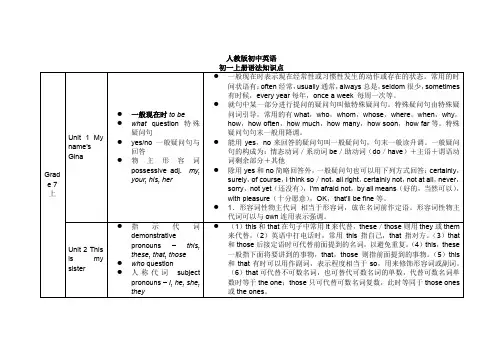
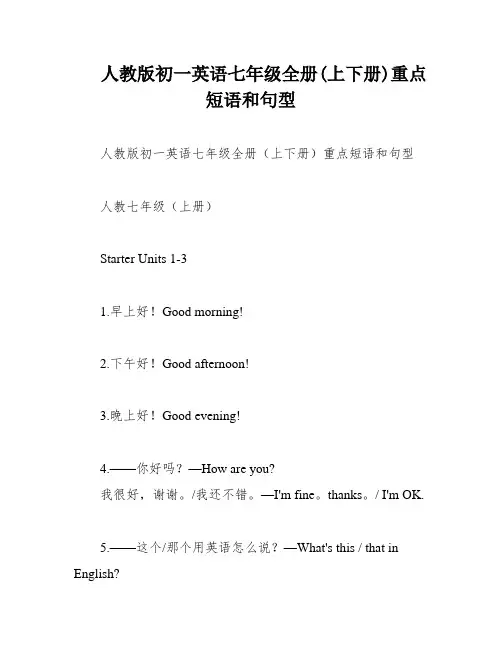
人教版初一英语七年级全册(上下册)重点短语和句型人教版初一英语七年级全册(上下册)重点短语和句型人教七年级(上册)Starter Units 1-31.早上好!Good morning!2.下午好!Good afternoon!3.晚上好!Good evening!4.——你好吗?—How are you?我很好,谢谢。
/我还不错。
—I'm fine。
thanks。
/ I'm OK.5.——这个/那个用英语怎么说?—What's this / that in English?是……—It's a / an。
6.请拼写它。
Spell it。
please.7.——它是什么颜色的?—What color is it? 它是……色的。
—It's。
Unit 1n A1.我是……I'm。
2.你是……吗?Are you。
3.他/她是……He / She is。
4.——见到你很高兴。
—Nice to meet you.见到你我也很高兴。
—Nice to meet you。
too.5.——你/他/她叫什么名字?—What's your / his / her name?我/他/她叫……—My / His / Her name is。
n B1.名字first name2.姓last name3.在中国in China4.学生卡ID card5.这是你的号码吗?Is this your number?6.——你的电话号码是多少?—What's your telephone / phone number?是……—It's。
Unit 2n A1.家庭照片family photos2.这是/那是/这些是/那些是……This is / That is / These are / Those are。
3.她/他是谁?Who's she / he?4.他们是谁?Who are they?5.祝你过得愉快!Have a good day!6.我知道了。

初一人教版英语单词表上册序号 英文 中文序号 英文 中文1good/ɡʊd/adj.好的25Eric/ˈerɪk/埃里克(男名)2morning/ˈmɔːnɪŋ/n.早晨;上午26Frank/fræŋk/弗兰克(男名)3Good morning!早上好!27Grace/siː/格蕾丝(女名)4hi/haɪ/interj.(用于打招呼)嗨;喂28Helen/ˈhelən/海伦(女名)5hello/həˈləʊ/interj.你好;喂29name/neɪm/n.名字;名称6afternoon/ˌɑːftəˈnuːn/n.下午30nice/naɪs/adj.令人愉快的;宜人的7Good afternoon!下午好!31meet/miːt/v.遇见;相逢8evening/ˈiːvnɪŋ/n.晚上;傍晚32too/tuː/adv.也;又;太9Good evening!晚上好!33your/jɔː(r)/pron.你的;你们的10how/haʊ/adv.怎样;如何34Ms./mɪz; məz/(用于女子的姓名前,不指明婚否)女士11are/ə(r)/v.是35his/hɪz/pron.他的12you/ju/pron.你;你们36and/ənd/conj.和;又;而13How are you?你好吗?37her/hə(r)/pron.她的14I/aɪ/pron.我38yes/jes/interj.是的;可以15am/əm/v.是39she/ʃi/pron.她16fine/faɪn/adj.健康的;美好的40he/hi/pron.他17thanks/θæŋks/interj.&n.感谢;谢谢41no/nəʊ/adv.&adj.不;没有;不是18OK/əʊ ˈkeɪ/interj.&ad好;可以42not/nɒt/adv.不;没有19HB(铅笔芯)硬黑43zero/ˈzɪərəʊ/num.零20CD/ˌsiː ˈdiː/光盘;激光唱片44one/wʌn/num.一21Alice/ˈælɪs/艾丽斯(女名)45two/tuː/num.二22Bob/ˈbɒb/鲍勃(男名)46three/θriː/num.三23Cindy/ˈsɪndi/辛迪(女名)47four/fɔː(r)/num.四24Dale/deɪl/戴尔(男名)48five/faɪv/num.五49six/sɪks/num.六74Mary/ˈmæri/玛丽(女名)50seven/ˈsevn/num.七75Miller/ˈmɪlə(r)/米勒(姓)51eight/eɪt/num.八76Linda/ˈlɪndə/琳达(女名)52nine/naɪn/num.九77Jane/dʒeɪn/简(女名)53telephone/ˈtelɪfəʊn/n.电话;电话机78green/ɡriːn/格林(姓)54number/ˈnʌmbə(r)/n.号码;数字79Smith/smɪθ/史密斯(姓)55phone/fəʊn/n.电话;电话机80what/wɒt/pron.&adj.什么56telephone/phone number电话号码81is/ɪz/v.是57first/fɜːst/adj.第一82this/ðɪs/pron.这;这个58first name名字83in/ɪn/prep.(表示使用语音;材料等)用;以59last/lɑːst/adj.最后的;末尾的84English/ˈɪŋɡlɪʃ/n.英语60last name姓85English/ˈɪŋɡlɪʃ/adj.英格兰的;英语的61friend/frend/n.朋友86in English用英语62China/ˈtʃaɪnə/中国87map/mæp/n.地图63middle/ˈmɪdl/adj.中间的88cup/kʌp/n.杯子64middle/ˈmɪdl/n.中间89ruler/ˈruːlə(r)/n.尺;直尺65school/skuːl/n.学校90pen/pen/n.笔;钢笔66middle school中学;初中91orange/ˈɒrɪndʒ/n.橙子67Gina/ˈdʒiːnə/吉娜(女名)92jacket/ˈdʒækɪt/n.夹克衫;短上衣68Jenny/ˈdʒeni/珍妮(女名)93key/kiː/n.钥匙69brown/braʊn/布朗(姓)94quilt/kwɪlt/n.被子;床罩70Alan/ˈælən/艾伦(男名)95it/ɪt/pron.它71Tom/tɒm/汤姆(男名)96a(an)/ə, æn/art.(用于单数可数名词前,表示未曾提到的)一(人、事、物)72Mike/maɪk/迈克(男名)97spell/spel/v.用字母拼;拼写73Jack/dʒæk/杰克(男名)98please/pliːz/interj.(用语客气地请求或吩咐)请99NBA(National Basketball Association) (美国)全国篮球协会124aunt/ɑːnt/n.姑母;姨母;伯母;婶母;舅母100P/piː/停车场;停车位125grandma/ˈɡrænmɑː/n.(外)祖母;奶奶;外婆;姥姥101Kg/ˈkɪləˌɡræm/千克;公斤126Dad/dæd/n.爸爸102sister/ˈsɪstə(r)/n.姐;妹127uncle/ˈʌŋkl/n.舅父;叔父;伯父;姑父;姨父103mother/ˈmʌðə(r)/n.母亲;妈妈128daughter/ˈdɔːtə(r)/n.女儿104father/ˈfɑːðə(r)/n.父亲;爸爸129here/hɪə(r)/adv.(用以介绍某人或某物)这就是;在这里105parent/ˈpeərənt/n.父(母)亲130photo/ˈfəʊtəʊ/n.照片106brother/ˈbrʌðə(r)/n.兄;弟131of/əv/prep.属于(某人或某物);关于(某人或某物)107grandmother/ˈɡrænmʌðə(r)/n.(外)祖母;奶奶;外婆;姥姥132next/nekst/adj.&n.下一个(的);接下来(的)108grandfather/ˈɡrænfɑːðə(r)/n.(外)祖父;爷爷;外公;姥爷133picture/ˈpɪktʃə(r)/n.照片;图画109grandparent/ˈɡrænpeərənt/n.祖父(母);(外)祖父(母)134girl/ɡɜːl/n.女孩110family/ˈfæməli/n.家;家庭135dog/dɒɡ/n.狗111those/ðəʊz/pron.那些136Sally/ˈsæli/萨莉(女名)112who/huː/pron.谁;什么人137Kate/keɪt/凯特(女名)113oh/əʊ/interj.哦;啊138Paul/pɔːl/保罗(男名)114these/ðiːz/pron.这些139John/dʒɒn/约翰(男名)115they/ðeɪ/pron.他(她、它)们140color/ˈkʌlə(r)/n.(=colour)颜色116well/wel/interj.嗯;好吧141red/red/adj.&n.红色(的)117day/deɪ/n.一天;一日;白天142yellow/ˈjeləʊ/adj.&n.黄色(的)118Have a good day!(表示祝愿)过得愉快!143green/ɡriːn/adj.&n.绿色(的)119bye/baɪ/interj.(=goodbye)再见144blue/bluː/adj.&n.蓝色(的)120son/sʌn/n.儿子145black/blæk/adj.&n.黑色(的)121cousin/ˈkʌzn/n.堂兄(弟、姐、妹);表兄(弟、姐、妹)146white/waɪt/adj.&n.白色(的)122grandpa/ˈɡrænpɑː/n.(外)祖父;爷爷;外公;姥爷147purple/ˈpɜːpl/adj.&n.紫色(的)123mom/mɒm/n.(=mum)妈妈148brown/braʊn/adj.&n.棕色(的);褐色(的)149now/naʊ/adv.现在;目前154S/es/(尤指服装的尺码)小号的150see/siː/v.理解;明白155M/em/(尤指服装的尺码)中号的151can/kən/modal v.能;会156L/el/(尤指服装的尺码)大号的152say/seɪ/v.说,讲157UFO/ˌjuː ef ˈəʊ; ˈjuːfəʊ/不明飞行物153my/maɪ/pron.我的158CCTV/ˌsiːsiːtiːˈviː/中国中央电视台初一人教版英语单词表上册序号 英文 中文序号 英文 中文1pencil/ˈpensl/n.铅笔25baseball/ˈbeɪsbɔːl/n.棒球2book/bʊk/n.书26watch/wɒtʃ/n.表;手表3eraser/ɪˈreɪzə(r)/n.橡皮27computer/kəmˈpjuːtə(r)/n.计算机;电脑4box/bɒks/n.箱;盒28game/ɡeɪm/n.游戏;运动;比赛5pencil box铅笔盒;文具盒29card/kɑːd/n.卡片6schoolbag/ˈskuːlbæɡ/n.书包30ID card学生卡;身份证7dictionary/ˈdɪkʃənri/n.词典;字典31notebook/ˈnəʊtbʊk/n.笔记本8his/hɪz/pron.他的32ring/rɪŋ/n.戒指9mine/maɪn/pron.我的33bag/bæɡ/n.袋;包10hers/hɜːz/pron.她的34in/ɪn/prep.在……里11excuse/ɪkˈskjuːs/v.原谅;宽恕35library/ˈlaɪbrəri/n.图书馆12me/mi/pron.(I的宾格)我36ask/ɑːsk/v.请求;要求;询问13excuse me劳驾;请原谅37ask...for...请求;恳求(给予)14thank/θæŋk/v.感谢;谢谢38find/faɪnd/v.(过去式、过去分词found)找到;发现15teacher/ˈtiːtʃə(r)/n.老师;教师39some/sʌm/adj.一些;某些16about/əˈbaʊt/prep.关于40some/sʌm/pron.有些;有的17about/əˈbaʊt/adv.大约41classroom/ˈklɑːsruːm/n.教室18What about...?(询问消息或提出建议)……怎么样?……好吗42e-mail/ˈiː meɪl/v.(=email)给……发电子邮件;用电邮发送19yours/jɔːz/pron.你的;你们的43e-mail/ˈiː meɪl/n.(=email)电子邮件20thank/θæŋk/prep.谢谢44call/kɔːl/v.给(……)打电话21thank you for...为……而感谢你(们)45lost/lɒst/v.(动词lose的过去式)遗失;丢失22help/help/v.&n.帮助;援助46must/məst/modal v.必须23welcome/ˈwelkəm/adj.受欢迎的47set/set/n.一套;一副;一组24You're welcome.别客气。

人教版初一上册英语知识点归纳总结一、48个国际音标及26个英文字母的正确书写要熟练掌握元音和辅音,5个元音字母(a, e, i, o, u),字母的正确占格及单词间距。
二、be动词的用法be动词有三种变形,分别是:am, is, are。
记忆口诀:"我"用am, "你"用are, is用于"他、她、它";单数全都用is,复数全部都用are。
三、人称及人称代词的不同形式(主格和宾格)1、三种人称:第一人称(I, we),第二人称(you, you),第三人称(he, she, it, Maria)。
2、人称代词的主格,即人称代词位于句子主语位置时的形态:I, We, You, You, He, She, It, Maria。
3、人称代词的宾格,即人称代词位于句子宾语位置时的形状:me, us, you, you, him, her, it。
4、形容词性物主代词:my, our, your, your, his, her, its, their。
5、名词性物主代词:mine, ours, yours, yours, his, hers, its, theirs。
6、反身代词:myself, ourselves, yourself, yourselves, himself, herself, itself,XXX。
四、基数词(表示数量多少的词,大致相当于代数里的自然数)zero, one, two, three, four, five, six, seven, eight, nine, ten, eleven, XXX,XXX, fourteen, fifteen, XXX, XXX, XXX, XXX, XXX,XXX-one, twenty-two, XXX-three,twenty-four, XXX-five, XXX-six,XXX-seven, XXX-eight, XXX-nine, thirty, forty, fifty, sixty,XXX,eighty, ninety, one hundred,one XXX。
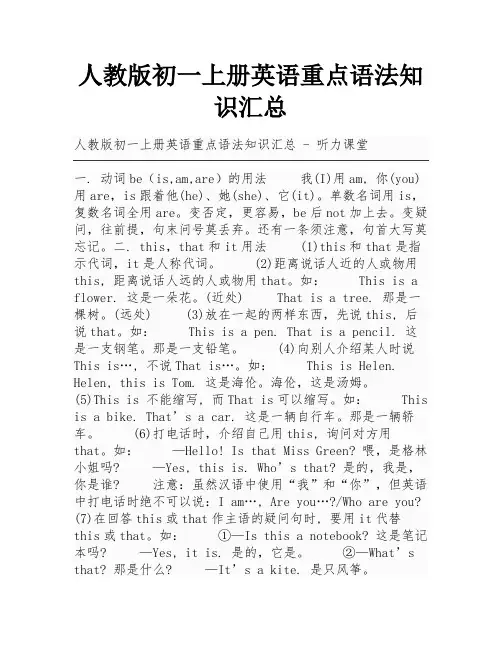
人教版初一上册英语重点语法知识汇总一. 动词be(is,am,are)的用法我(I)用am, 你(you)用are,is跟着他(he)、她(she)、它(it)。
单数名词用is,复数名词全用are。
变否定,更容易,be后not加上去。
变疑问,往前提,句末问号莫丢弃。
还有一条须注意,句首大写莫忘记。
二. this,that和it用法(1)this和that是指示代词,it是人称代词。
(2)距离说话人近的人或物用this, 距离说话人远的人或物用that。
如:This is a flower. 这是一朵花。
(近处) That is a tree. 那是一棵树。
(远处) (3)放在一起的两样东西,先说this, 后说that。
如:This is a pen. That is a pencil. 这是一支钢笔。
那是一支铅笔。
(4)向别人介绍某人时说This is…, 不说That is…。
如:This is Helen. Helen, this is Tom. 这是海伦。
海伦,这是汤姆。
(5)This is 不能缩写, 而That is可以缩写。
如:This is a bike. That’s a car. 这是一辆自行车。
那是一辆轿车。
(6)打电话时,介绍自己用this, 询问对方用that。
如:—Hello! Is that Miss Green? 喂,是格林小姐吗? —Yes, this is. Who’s that? 是的,我是,你是谁? 注意:虽然汉语中使用“我”和“你”,但英语中打电话时绝不可以说:I am…, Are you…?/Who are you?(7)在回答this或that作主语的疑问句时, 要用it代替this或that。
如:①—Is this a notebook? 这是笔记本吗? —Yes, it is. 是的,它是。
②—What’s that? 那是什么? —It’s a kite. 是只风筝。
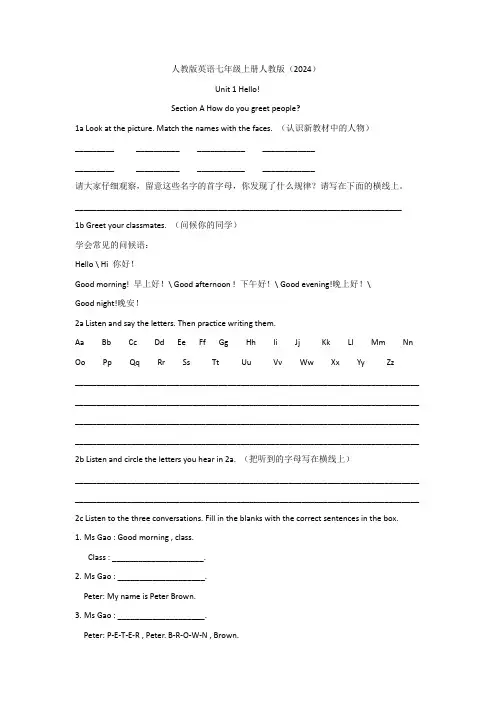
人教版英语七年级上册人教版(2024)Unit 1 Hello!Section A How do you greet people?1a Look at the picture. Match the names with the faces. (认识新教材中的人物)_________ __________ ___________ _____________________ __________ ___________ ____________请大家仔细观察,留意这些名字的首字母,你发现了什么规律?请写在下面的横线上。
___________________________________________________________________________1b Greet your classmates. (问候你的同学)学会常见的问候语:Hello \ Hi 你好!Good morning! 早上好!\ Good afternoon ! 下午好!\ Good evening!晚上好!\Good night!晚安!2a Listen and say the letters. Then practice writing them.Aa Bb Cc Dd Ee Ff Gg Hh Ii Jj Kk Ll Mm Nn Oo Pp Qq Rr Ss Tt Uu Vv Ww Xx Yy Zz_______________________________________________________________________________ _______________________________________________________________________________ _______________________________________________________________________________ _______________________________________________________________________________ 2b Listen and circle the letters you hear in 2a. (把听到的字母写在横线上)_______________________________________________________________________________ _______________________________________________________________________________ 2c Listen to the three conversations. Fill in the blanks with the correct sentences in the box.1.Ms Gao : Good morning , class.Class : _____________________.2.Ms Gao : ____________________.Peter: My name is Peter Brown.3.Ms Gao : ____________________.Peter: P-E-T-E-R , Peter. B-R-O-W-N , Brown.2d Make up a conversation to greet each other.A: Good morning.B: ____________________. What’s your name?A: ___________________________.B: How do you spell your name ?A: _____________________.B: Goodbye.A: ______________________.Pronunciation1 Listen to the 26 letters. Find then on the keyboard. Then practice with a partner. Where is A?A is here.2 Listen and repeat the letters.1./e ɪ / Aa Hh Jj Kk2./i:/ Bb Cc Dd Ee Gg Pp Tt Vv Zz3./e/ Ff Mm Nn Ss Xx Zz4./ai / Ii Yy5./ju:/ Qq Uu Ww6./əʊ/ Oo7./a:/ Rr3 Listen to these letters. Match them with the pictures.1.PLA _________________2.VR __________________3.CD __________________4.PRC ___________________5.UN ___________________4 Listen and sing the songA ,B ,C ,D ,E ,F ,G ,H , I , J , K , L , M , N ,O , P , Q , R , S , T .U , V , W , X , Y , Z.X , Y , Z —now you see ,I can say my ABCs.本部分知识点回顾:1、问候他人:一天的各个时间段遇见,用Good + 时间;例如:Good morning ! 早上好!\ Good afternoon ! 下午好!\ Good evening ! 晚上好!\ Good night ! 晚安!Hello , Hi 用于向他人问候。
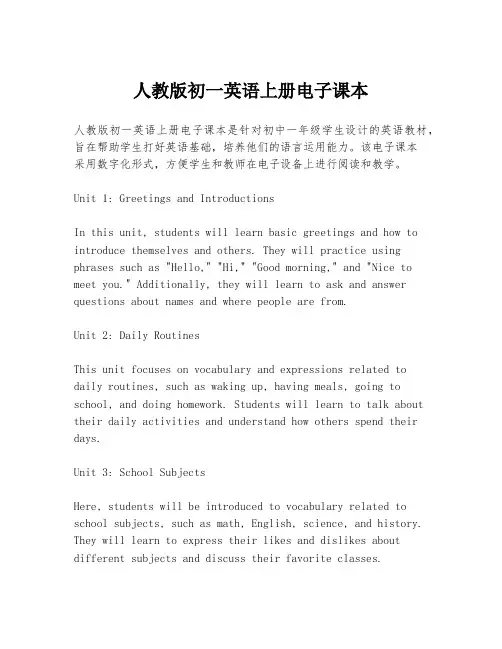
人教版初一英语上册电子课本人教版初一英语上册电子课本是针对初中一年级学生设计的英语教材,旨在帮助学生打好英语基础,培养他们的语言运用能力。
该电子课本采用数字化形式,方便学生和教师在电子设备上进行阅读和教学。
Unit 1: Greetings and IntroductionsIn this unit, students will learn basic greetings and how to introduce themselves and others. They will practice using phrases such as "Hello," "Hi," "Good morning," and "Nice to meet you." Additionally, they will learn to ask and answer questions about names and where people are from.Unit 2: Daily RoutinesThis unit focuses on vocabulary and expressions related to daily routines, such as waking up, having meals, going to school, and doing homework. Students will learn to talk about their daily activities and understand how others spend their days.Unit 3: School SubjectsHere, students will be introduced to vocabulary related to school subjects, such as math, English, science, and history. They will learn to express their likes and dislikes about different subjects and discuss their favorite classes.Unit 4: ColorsIn this unit, students will explore the English vocabularyfor colors. They will learn to name and describe various colors, as well as use color-related adjectives to describe objects and clothing.Unit 5: Numbers 1-100This unit is all about numbers. Students will learn to count from one to one hundred, use numbers in everyday contexts, and perform basic numerical operations such as addition and subtraction.Unit 6: Family and FriendsStudents will learn vocabulary related to family members and friends. They will be able to talk about their relatives, describe family relationships, and discuss their friendships.Unit 7: Food and DrinksIn this unit, students will explore the English language asit relates to food and drinks. They will learn to name different types of food and beverages, talk about their preferences, and order food in a restaurant.Unit 8: Daily LifeThis unit covers a range of topics related to daily life, such as shopping, sports, and entertainment. Students willlearn vocabulary and expressions to discuss their hobbies, favorite sports, and shopping experiences.Unit 9: TravelStudents will learn about travel-related vocabulary and phrases in this unit. They will be able to talk about different modes of transportation, describe their travel experiences, and ask for directions.Unit 10: Festivals and HolidaysIn the final unit, students will learn about variousfestivals and holidays celebrated around the world. They will learn to talk about cultural traditions, holiday customs, and how people celebrate special occasions.Each unit is designed with a variety of activities, including listening, speaking, reading, and writing exercises, to ensure that students develop a well-rounded understanding of the English language. The electronic format of the textbook also includes interactive elements, such as audio clips for pronunciation practice and digital quizzes for self-assessment.。
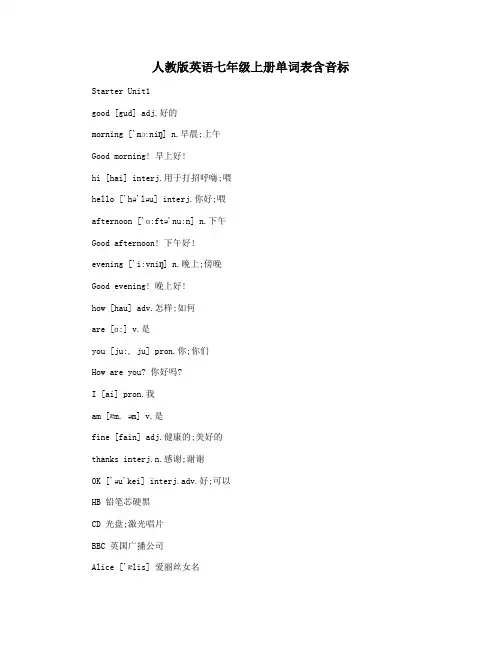
人教版英语七年级上册单词表含音标 Starter Unit1good [gud] adj.好的morning ['mɔ:niŋ] n.早晨;上午Good morning! 早上好!hi [hai] interj.用于打招呼嗨;喂hello ['hə'ləu] interj.你好;喂afternoon ['ɑ:ftə'nu:n] n.下午Good afternoon! 下午好!evening ['i:vniŋ] n.晚上;傍晚Good evening! 晚上好!how [hau] adv.怎样;如何are [ɑ:] v.是you [ju:, ju] pron.你;你们How are you? 你好吗?I [ai] pron.我am [æm, əm] v.是fine [fain] adj.健康的;美好的thanks interj.n.感谢;谢谢OK ['əu'kei] interj.adv.好;可以HB 铅笔芯硬黑CD 光盘;激光唱片BBC 英国广播公司Alice ['ælis] 爱丽丝女名Bob [bɔb] 鲍勃男名Cindy 辛迪女名Dale [deil] 戴尔男名Eric ['erek] 埃里克男名Frank [fræŋk] 弗兰克男名Grace [greis] 格雷丝女名Helen ['helin] 海伦女名Starter Unit2what [wɔt] pron.adj.什么is [iz] v.是this [ðis] pron.这;这个in [in] prep.表示使用语言、材料等用;以English ['iŋgliʃ] n.英语 adj.英格兰的;英语的 in English 用英语map [mæp] n.地图cup [kʌp] n.杯子ruler [';] n.尺;直尺pen [pen] n.笔;钢笔orange ['ɔrindʒ] n.橙子jacket ['dʒækit] n.夹克衫;短上衣key [ki:] n.钥匙quilt [kwilt] n.被子;床罩it [it] pron.它a [ei, ə] art.一人、事、物that [ðæt] pron.那;那个spell [spel] v.用字母拼;拼写please [pli:z] interj.请NBA 美国全国篮球联赛P 停车场;停车位kg n.千克;公斤Starter Unit3color ['kʌlə] n.颜色red [red] adj.n.红色的yellow ['jeləu] adj.n.黄色的green [gri:n] adj.n.绿色的blue [blu:] adj.n.蓝色的black [blæk] adj.n.黑色的white [wait] adj.n.白色的purple ['pə:pl] adj.n.紫色的brown [braun] adj.n.褐色的;棕色的the [ðə, ði] art.指已被提到或易领会到的人或事物 now [nau] adv.现在;目前see [si:] v.理解;明白can [kæn] modal v.能;会say [sei] v.说;讲my [mai] pron.我的S 尤指服装的尺码小号的M 尤指服装的尺码中号的L 尤指服装的尺码大号的UFO 不明飞行物CCTV 中国中央电视台Unit1name ['neim] n.名字;名称nice ['nais] adj.令人愉快的;宜人的to [tu:, tu, tə] 常用于原形动词之前,表示该动词为不定式 meet [mi:t] v.遇见;相逢too [tu:] adv.也;又;太your [jɔ:] pron.你的;你们的Ms. n.不指名婚否女士his [his] pron.他的and [ænd, ənd] conj.和;又;而her [hə:, hə] pron.她的yes [jes] interj.是的;可以she [ʃi:, ʃi] pron.她he [hi:] pron.他no [nəu] interj.不;没有;不是not [nɔt] adv.不;没有zero ['ziərəu] num.零one [wʌn] num.一two [tu:] num.二three [θri:] num.三four [fɔ:] num.四five [faiv] num.五six [siks] num.六seven ['seven] num.七eight [eit] num.八nine [nain] num.九telephone ['telifəun] n.电话;电话机 number ['nʌmbə] n.号码;数字phone [fəun] n.电话telephone/phone number 电话号码first [fə:st] adj.第一first name n.名字last [lɑ:st] adj.最后的;末尾的last name 姓friend [frend] n.朋友China ['tʃainə] 中国middle ['midl] adj.中间的 n.中间school [sku:l] n.学校middle school 中学;初中Gina 吉娜女名Jenny ['dʒeni, 'dʒini] 珍妮女名Brown [braun] 布朗姓Alan ['ælən] 艾伦男名Tom [tɔm] 汤姆男名Mike [maik] 迈克男名Jack [dʒæk] 杰克男名Mary ['mɛəri] 玛丽女名Miller ['milə] 米勒姓Linda ['lində] 琳达女名Jane [dʒein] 简女名Green [gri:n] 格林姓Smith [smiθ] 史密斯姓Unit2sister [sistə] n.姐;妹mother ['mʌðə] n.母亲;妈妈father ['fɑ:ðə] n.父亲;爸爸parent ['pɛərənt] n.父母亲brother ['brʌðə] n.兄;弟grandmother ['grænd'mʌðə] n.外祖母;奶奶;外婆;姥姥grandfather ['grænd'fɑ:ðə] n.外祖父;爷爷;外公;姥爷grandparent ['grændperənt] n.祖父母;外祖父母family ['fæmili] n.家;家庭those [ðəuz] pron.那些who [hu:] pron.谁;什么人oh [əu] int.哦;啊these [ði:z] adv.这些they [ðei] pron.他她、它们well [wel] interj.嗯;好吧have [hæv, həv] v.经受;经历day [dei] n.一天;一日;白天Have a good day! 表示祝愿过得愉快!bye [bai] 再见son [sʌn] n.儿子cousin ['kʌzn] n.堂兄弟、姐、妹;表兄弟、姐、妹grandpa ['grænpɑ:] n.口语外祖父;爷爷;外公;姥爷 mom [mɔm] n.=mum妈妈aunt [ɑ:nt] n.姑母;姨母;伯母;婶母;舅母grandma ['grænmɑ:] n.口语外祖母;奶奶;外婆;姥姥dad [dæd] n.爸爸uncle ['ʌŋkl] n.舅父;叔父;伯父;姑父;姨父daughter ['dɔ:tə] n.女儿here [hiə] adv.这就是;在这里photo ['fəutəu] n.照片of [ɔv, əv] prep.属于;关于next [nekst] n.adj.下一个的;接下来的picture ['piktʃə] n.照片;图画girl [gə:l] n.女孩dog [dɔg] n.狗Sally ['sæli] n.萨莉女名Kate [keit] n.凯特女名Paul [pɔ:l] n.保罗男名Unit3pencil ['pensl] n.铅笔book [buk] n.书eraser [i'reizə] n.橡皮box [bɔks] n.箱;盒pencil box 铅笔盒;文具盒schoolbag n.书包dictionary ['dikʃənəri] n.词典;字典his [his] pron.他的mine [main] pron.我的hers [hə:z] pron.她的excuse [iks'kju:z, iks'kju:s] v.原谅;宽恕 me [mi:, mi] pron.我excuse me 劳驾;请原谅thank [θæŋk] v.感谢;谢谢teacher [';] n.老师;教师about [ə'baut] prep.关于What about...? …怎么样?…好吗?yours [jɔ:z] pron.你的;你们的for [fɔ:, fə] prep.为了;对thank you for... 为…而感谢help [help] v.n.帮助;援助welcome ['welkəm] adj.受欢迎的You're welcome 别客气。
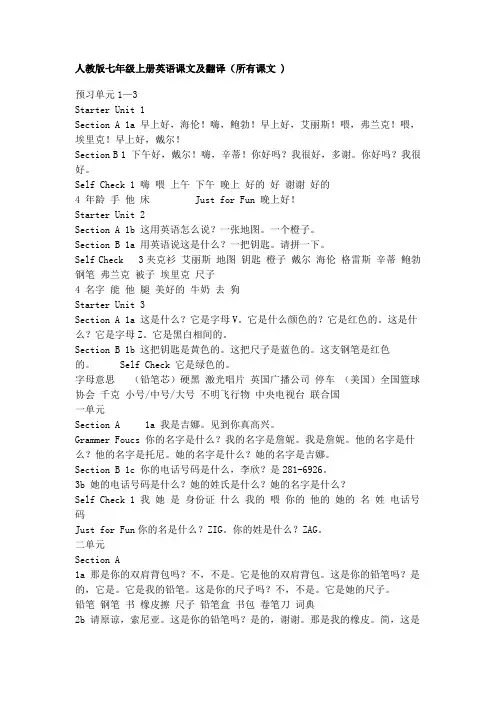
人教版七年级上册英语课文及翻译(所有课文 )预习单元1—3Starter Unit 1Section A 1a 早上好,海伦!嗨,鲍勃!早上好,艾丽斯!喂,弗兰克!喂,埃里克!早上好,戴尔!Section B 1 下午好,戴尔!嗨,辛蒂!你好吗?我很好,多谢。
你好吗?我很好。
Self Check 1 嗨喂上午下午晚上好的好谢谢好的4 年龄手他床 Just for Fun 晚上好!Starter Unit 2Section A 1b 这用英语怎么说?一张地图。
一个橙子。
Section B 1a 用英语说这是什么?一把钥匙。
请拼一下。
Self Check 3夹克衫艾丽斯地图钥匙橙子戴尔海伦格雷斯辛蒂鲍勃钢笔弗兰克被子埃里克尺子4 名字能他腿美好的牛奶去狗Starter Unit 3Section A 1a 这是什么?它是字母V。
它是什么颜色的?它是红色的。
这是什么?它是字母Z。
它是黑白相间的。
Section B 1b 这把钥匙是黄色的。
这把尺子是蓝色的。
这支钢笔是红色的。
Self Check 它是绿色的。
字母意思(铅笔芯)硬黑激光唱片英国广播公司停车(美国)全国篮球协会千克小号/中号/大号不明飞行物中央电视台联合国一单元Section A 1a 我是吉娜。
见到你真高兴。
Grammer Foucs 你的名字是什么?我的名字是詹妮。
我是詹妮。
他的名字是什么?他的名字是托尼。
她的名字是什么?她的名字是吉娜。
Section B 1c 你的电话号码是什么,李欣?是281-6926。
3b 她的电话号码是什么?她的姓氏是什么?她的名字是什么?Self Check 1 我她是身份证什么我的喂你的他的她的名姓电话号码Just for Fun你的名是什么?ZIG。
你的姓是什么?ZAG。
二单元Section A1a 那是你的双肩背包吗?不,不是。
它是他的双肩背包。
这是你的铅笔吗?是的,它是。
它是我的铅笔。
这是你的尺子吗?不,不是。
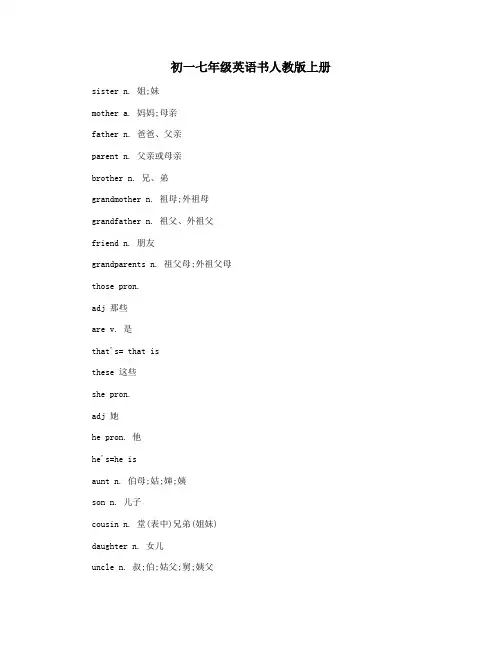
初一七年级英语书人教版上册 sister n. 姐;妹mother a. 妈妈;母亲father n. 爸爸、父亲parent n. 父亲或母亲brother n. 兄、弟grandmother n. 祖母;外祖母grandfather n. 祖父、外祖父friend n. 朋友grandparents n. 祖父母;外祖父母those pron.adj 那些are v. 是that's= that isthese 这些she pron.adj 她he pron. 他he's=he isaunt n. 伯母;姑;婶;姨son n. 儿子cousin n. 堂(表中)兄弟(姐妹)daughter n. 女儿uncle n. 叔;伯;姑父;舅;姨父picture n. 照片; 图画dear adj。
(并列于信函中的称呼)亲爱的; for prep 这了thanks for 为…而非常感谢photo n. 照片;相片here adv 这里;在这里dave 戴夫(男名)anna 安娜(女名)paul 保罗(男名)emma 艾玛(女名)mona 莫娜(女名)this adj 这;这个pencil n. 铅笔pen n. 钢笔book n. 书eraser n. 橡皮;铅笔擦拭;黑板擦ruler n. 尺;直尺case n. 箱;盒;橱pencil case 铅笔盒;文具盒backpack n. 双肩背包pencil sharpener 卷笔刀;铅笔刀dictionary n. 字典;词典that pron. 那;那个yes adv (则表示确实)就是no adv (表示否定)不;不是not ad. (形成驳斥形式)不是isn't=is not 不是excuse v. 原谅;原谅excuse me. 请原谅thank[-s] int. 谢谢ok a. 好;不错in prep. 用(则表示方法、媒介、工具等)english n. 英语;英文a a.. 一个(只;把;台…)how adv (指程度)多么;何等; 怎样do aux. 搞;干活;形成否定句、疑问句的助动词 spell v. 拼写baseball n. 棒球watch n. 手表computer n. 电脑;电子计算机game n. 游戏computer game 电子游戏key n. 钥匙notebook n. 笔记本ring n. 环;戒指call v. 打电话at prep. 在…里面或附近;在…(点、刻);以in prep. 在…里面the ad. 表示特指的人、物或群体lost v 遗失found v. 找回lost and found 失物招领处 please v. 请school n. 学校a set of 一套;一台of prep. (所属)…的tim 蒂姆(男名)sonia 索尼娅(女名)jane 凯思(女名)david 大卫(男名)when adv. 什么时候;何时 birthday n. 生日month n. 月;月份january n. 一月;正月february n. 二月march n. 三月april n. 四月may n. 五月june n. 六月july n. 七月august n. 八月september n. 九月october n. 十月november n. 十一月december n. 十二月tenth nu 第十fourth nu 第四fifteenth nu 第十五second nu 第二third nu 第三fifth nu 第五sixth nu 第六seventh nu 第七eighth nu 第八ninth nu 第九eleventh nu 第十一twelfth nu 第十二thirteenth nu 第十三fourteenth nu 第十四sixteenth nu 第十六seventeenth nu 第十七eighteenth nu 第十八nineteenth nu 第十九twentieth nu 第二十thirtieth nu 第三十date n. 日期happy a. 愉快的;高兴的;满意的 happy birthday! 生日快乐!birth n. 出生;出世;诞生age n. 年龄;年纪old a. 年岁的;年老的;年长的how old 多小岁数;几岁speech n. 演讲;讲演;说话;言论contest n. 竞争;竞赛;比赛party n. 聚会;晚会trip n. 旅途;观光旅行(常指短途)basketball game 篮球赛volleyball game 排球赛school day 学校庆祝日art n. 艺术;美术;艺术品festival n. (音乐、芭蕾舞、戏剧等的)节日 chinese n.adj. 中文;中国人中国的;中国人的musi. 音乐year n. 年years old …岁(年龄)vera 薇拉(女名)jeff 杰夫(男名)leila 莱拉(女名)robert 罗伯特(男名)john 约翰(男名)william 威廉(男名)tina 蒂娜(女名)johnson 约翰逊(男名)。
初一上册英语书人教版单词表初一上册英语书人教版的单词表包含了这个学期所学习的所有单词。
我们将按照单元顺序介绍这些单词。
Unit 1: Greetings1. Good morning: Used as a greeting when seeing someone in the morning.2. Good afternoon: Used as a greeting when seeing someone in the afternoon.3. Good evening: Used as a greeting when seeing someone in the evening.4. Hello: Used as a general greeting.5. Hi: Informal greeting used with friends and acquaintances.6. How are you?: Commonly used to ask someone about their well-being.7. Fine: Used to express that one is feeling good or well.8. Great: Used to express that something is excellent or fantastic.9. Goodbye: Used to say farewell.10. See you later: Used to say goodbye with the intention of meeting again.Unit 2: My School1. School: An institution for learning.2. Classroom: A room where students have lessons.3. Desk: A piece of furniture with a flat surface where students sit and work.4. Chair: A piece of furniture that is used for sitting on.5. Teacher: A person who instructs students.6. Student: A person who is studying at school or college.7. Book: A written or printed work consisting of pages glued or sewn together.8. Pen: A writing instrument used to apply ink to a surface.9. Pencil: A writing instrument with a thin, cylindrical graphite core.10. Bag: A flexible container with an opening at the top.Unit 3: My Family1. Family: A group consisting of parents and children living together in a household.2. Father: Male parent.3. Mother: Female parent.4. Brother: Male sibling.5. Sister: Female sibling.6. Grandfather: Father of one's father or mother.7. Grandmother: Mother of one's father or mother.8. Son: Male child.9. Daughter: Female child.10. Baby: A very young child.Unit 4: Daily Routine1. Wake up: Stop sleeping; become or make someone awake.2. Get up: Leave one's bed.3. Brush: Clean or tidy with a brush.4. Teeth: Hard calcified structures that grow in the jaws of humans.5. Wash: Clean oneself by using water and soap or other cleaning products.6. Face: Front part of a person's head from the forehead to the chin.7. Breakfast: The first meal of the day.8. Go to school: Travel to a place of study.9. Lunch: A meal eaten in the middle of the day.10. Dinner: The main meal of the day, usually taken in the evening.Unit 5: Hobbies1. Hobby: An activity done regularly in one's leisure time for pleasure.2. Read: Look at and comprehend the meaning of written or printed matter.3. Draw: Produce a picture or diagram by making lines and marks on paper.4. Dance: Move rhythmically to music.5. Sing: Make musical sounds with the voice.6. Swim: Propel the body through water using limbs.7. Play: Engage in activity for enjoyment and recreation.8. Football: A game played with a round ball between two teams of eleven players.9. Basketball: A game played between two teams of five players each.10. Music: Vocal or instrumental sounds combined in such a way as to produce beauty of form.Unit 6: Food and Drinks1. Food: Any nutritious substance that people or animals eat or drink.2. Fruit: Edible product of a tree or other plant.3. Vegetable: A plant or part of a plant used as food.4. Meat: The flesh of an animal used as food.5. Fish: A limbless cold-blooded vertebrate animal with gills and fins.6. Rice: A cereal plant giving small edible grains.7. Noodles: Long, thin strips made from dough.8. Bread: A staple food made from flour.9. Soup: A liquid dish, typically savory and made by boiling meat, fish, or vegetables.10. Water: A transparent, odorless, tasteless liquid essential for life.Unit 7: Colors1. Color: The property of objects that is dependent on their ability to transmit or reflect light.2. Red: A color at the longer-wavelength extreme of the visible spectrum, next to橙orange, and opposite to violet.3. Yellow: A color produced by mixing red and green light, or a primary color in the subtractive color system.4. Blue: A color characterized by a frequency of approximately 450-495 THz, at the short-wavelength extreme of the visible spectrum.5. Green: A color in the spectrum between yellow and blue, approximately 570-495 nanometers.6. Black: The absence of light or the color of complete darkness.7. White: A color of high lightness and no coloration, resulting from the reflection of all visible light.8. Pink: A pale red color, named after the flower the pink.9. Orange: A color resulting from a mixture of red and yellow, at a point midway between the two colors on the color wheel.10. Purple: A color resulting from the combination of red and blue light,iolet in the visible spectrum.Unit 8: Clothes1. Clothes: Articles of clothing.2. Shirt: A garment for the upper body, usually having a collar and long sleeves.3. Pants: A garment covering the lower part of the body, worn from the waist to the ankles.4. Dress: A garment for women or girls, typically consisting of a long, sleeveless top and a skirt.5. Skirt: A garment for women or girls, worn from the waist to the knees or lower, covering the legs.6. Shoes: Footwear designed to be worn on the feet, protect them from injury and other damage.7. Hat: A head covering.8. Coat: A garment worn on the upper body for warmth, protection, or style.9. Socks: A garment worn on the feet, which covers the ankle and the lower part of the leg.10. Shoes: Footwear designed to be worn on the feet, protect them from injury and other damage.Unit 9: Animals1. Animal: A living being that typically has a backbone, is eukaryotic, and is an organism which typically reacts to stimuli.2. Dog: A domesticated mammal (Canis lupus familiaris) that typically has a long snout, an acute sense of smell, non-retractile claws, and a barking, howling, or whining voice.3. Cat: A small carnivorous mammal (Felis catus) commonly kept as a pet.4. Elephant: A large mammal with a long trunk, large ears, and a long tail, native to Africa and Asia.5. Lion: A large carnivorous mammal (Panthera leo) of Africa and Asia, typically having a thick mane around the head and neck.6. Giraffe: A long-necked mammal (Giraffa camelopardalis) native to Africa.7. Monkey: Any of various anthropoid primates, especially those with a long tail or those of the families Cercopithecidae and Atelidae.8. Bird: A warm-blooded vertebrate animal characteristically having a beak, feathers, a body cavity, and laying eggs.9. Fish: A limbless cold-blooded vertebrate animal with gills and fins.10. Cow: A large, domesticated ungulate mammal (Bos taurus) kept as a source of milk and meat.Unit 10: Environment1. Sun: The star that is the center of our solar system, around which the Earth and other planets orbit.2. Moon: The natural satellite of the Earth, orbiting around it and causing tides.3. Sky: The region of clouds over a particular place, or the empty space above the Earth.4. Cloud: A visible mass of water droplets or ice crystals suspended in the atmosphere.5. Rain: Water falling from the clouds in the form of drops.6. Tree: A large, woody plant, typically having a single stem or trunk growing to a considerable height and bearing leaves, flowers, and fruit.7. Flower: The reproductive structure of a flowering plant, containing the male and female reproductive organs.这些是初一上册英语书人教版单词表中的部分单词,通过掌握这些单词,学生将能够更好地理解和运用英语。
人教版七年级上册英语教案16篇人教版七年级上册英语教案(精选篇1)一、复习指导思想新授课结束后,期末考试前,指导学生进行期末复习,主要复习基础知识,提高做题能力,训练阅读、听力与写作,使学生能够举一反三,熟练掌握知识点与考点.二、学生学习水平现状分析学生的主要问题是基础薄弱,做题能力参差不齐,优秀的学生不多,成绩有待于提高的学生比较多,一部分同学学习惰性强。
三、复习时间:十七周至十八周(共10课时)四、复习重点1、基础知识:unit1—unit8:重点词汇、短语、句型2、语法:(1)动词不定式(2)动名词(3)被动语态(4)形容词相关句型的运用(5)副词的运用(6)原因状语从句(7)过去进行时3、阅读训练(报纸阅读材料)4、听力(报纸、导学案套题听力训练)5、话题写作:肢体语言,义务工作,传统技艺,卡通漫画、动物保护、动物描写、未来生活畅想6、复习中注重讲练结合,及时反馈,及时检测五、课时安排时间为两周,具体计划如下:十七周(周一)unit1、2重点词组句型小结;语法训练(报纸2、3版)十七周(周二)unit1、2知识点练习,话题写作训练(报纸4版)十七周(周三)unit3、4重点词组句型小结;语法训练(报纸5、6版)十七周(周四)unit3、4知识点练习,话题写作训练(报纸7版)十七周(周五)unit5、6重点词组句型小结;语法训练(报纸8、9版)十八周(周一)unit5、6知识点练习,话题写作训练(报纸10版)十八周(周二)unit7、8重点词组句型小结;语法训练(报纸11、12版)十八周(周三) unit7、8知识点练习,话题写作训练(报纸13版)十八周(周四)模拟套题(报纸31版)(综合测试一)十八周(周五)模拟套题(报纸32版)(综合测试二)六、复习措施1、单词过关。
每天重点句子听写2、语法复习注重讲练结合,引导学生说出重点与易错点3、加强整理英语学习档案4、对于阅读训练有指导,有检测。
人教版七年级上册初一上册英语第一单元优质课件一、教学内容本节课,我们将在人教版七年级上册英语第一单元展开学习。
具体内容包括:Unit 1 My name is Gina. 我们将重点学习section A 1a2d,掌握如何用英语进行自我介绍,询问和回答姓名、国籍等基本交际用语。
二、教学目标1. 让学生掌握本节课重点单词和短语,如name, last name, first name, China, class, grade等。
2. 培养学生运用所学知识进行自我介绍和询问他人姓名能力。
3. 提高学生听说能力,使他们能够在实际情景中运用所学知识进行交流。
三、教学难点与重点1. 教学难点:正确使用last name和first name,以及名词单复数变化。
2. 教学重点:自我介绍和询问他人姓名表达方式。
四、教具与学具准备1. 教具:多媒体课件、黑板、磁带等。
2. 学具:课本、练习本、彩色笔等。
五、教学过程1. 导入:通过播放一首英文歌曲《Hello, hello, hello》,让学生感受英语氛围,同时引出本节课主题——自我介绍。
2. 新课内容展示:a. 播放section A 1a录音,让学生跟读,学习如何用英语进行自我介绍。
b. 展示section A 2a图片,引导学生学习如何询问和回答姓名。
c. 通过小组合作,让学生练习自我介绍和询问他人姓名交际用语。
3. 例题讲解:a. 解析section A 2b对话,讲解如何询问和回答国籍。
b. 分析section A 2c练习,引导学生正确使用last name和first name。
4. 随堂练习:a. 让学生模仿section A 2a2c内容,进行自我介绍和询问他人姓名练习。
b. 教师随机抽取学生进行角色扮演,检验学生对所学知识掌握。
b. 学生分享学习心得,互相交流。
六、板书设计1. Unit 1 My name is Gina.2. 重点单词和短语:name, last name, first name, China, class, grade等。
人教版七年级初一英语上册复习各单元知识点归纳总结人教版七年级英语上册复习各单元知识点总结一、字母学习1.英语中共有26个字母。
其中的Aa,Ee,Ii,Oo,Uu5个字母被称为元音字母。
这五个元音字母是构成英语成千上万单词的核心,除了一些缩略词之外,其它任何一个英语单词,通常都应包含一个或多个元音字母。
26个字母中的其它21个字母被称为辅音字母。
2.字母书写的规格斜度:每个字母都要稍向右斜约10°左右,斜度要一致。
大写字母的书写规格是:上不顶天下立地。
即笔画的上端稍离第一线,笔画的下端必须紧贴第三线,不许离线也不许出格。
占中间格的小写字母有a,c,e,m,n,o,r,s,u,v,w,x,z13个,它们笔画的上端必须紧贴第二线,下端必须紧贴第三线,不许离线也不许出格。
占一格、二格的小写字母有b,d,h,k,l共5个,它们笔画的上端必须顶第一线,下端必须顶第三线,不许离线也不许出格。
小写字母i和t也占一格、二格。
但t的上端在第一格中间,短横重合第二线;i的小圆点在第一格中间稍偏下处。
占二格、三格的小写字母有g,q,y3个,它们的笔画的顶端要紧贴第二线,下端要紧贴第四线,不可离线也不可出格。
占一格、二格、三格的小写字母有f,j,p3个。
其中f的上端稍离第一线(和大写字母一样),下端紧贴第四线,短横重合第二线;j的小圆点与i的小圆点位置相同,下面一笔的上端顶第二线,下端紧贴第四线;p的上端略高于第二线,约占第一格的三分之一,下端紧贴第四线。
字母按所含音素归类表:/ei/字母:AaHhJjKk音标:[ei][eitʃ][dʒei][kei]/i:/字母:BbCcDdEeGgPpTtVv音标:[bi:][si:][di:][i:][dʒi:][pi:][ti:][vi:]/ai/字母:IiYy音标:[ai][wai]/əʊ/Oo/əʊ//ju:/字母:UuQqWw音标:/ju://kju://`dΛblju://ɑ:/Rr/ɑ://e/字母:FfLlMmNnSsXxZz音标:/ef//el//em//en//es//eks//zed/3.缩写词:HK香港ID身份PE体育课PRC中华人民共和国RMB人民币PLA中国人民解放军CCP中国共产党IOC国际奥林匹克委员会am上午pm下午cm厘米mm毫米4.英语句子的书写句子开头的第一个单词的第一个字母要大写,单词与单词之间要有适当的距离,一般为放入一个字母的空隙,句末要有标点符号,英语的句号是个实心圆点,而不是汉语中的小圆圈。
人教版初一上册英语知识点归纳总结一、词汇1、人称代词主格:I(我)、you(你/你们)、he(他)、she(她)、it(它)、we(我们)、they(他们/她们/它们)宾格:me(我)、you(你/你们)、him(他)、her(她)、it (它)、us(我们)、them(他们/她们/它们)2、指示代词this(这个)、that(那个)、these(这些)、those(那些)3、物主代词形容词性物主代词:my(我的)、your(你的/你们的)、his(他的)、her(她的)、its(它的)、our(我们的)、their(他们的/她们的/它们的)名词性物主代词:mine(我的)、yours(你的/你们的)、his(他的)、hers(她的)、its(它的)、ours(我们的)、theirs(他们的/她们的/它们的)4、数字基数词:one(一)、two(二)、three(三)、four(四)、five (五)、six(六)、seven(七)、eight(八)、nine(九)、ten (十)、eleven(十一)、twelve(十二)、thirteen(十三)、fourteen (十四)、fifteen(十五)、sixteen(十六)、seventeen(十七)、eighteen(十八)、nineteen(十九)、twenty(二十)、thirty(三十)、forty(四十)、fifty(五十)、sixty(六十)、seventy(七十)、eighty(八十)、ninety(九十)、hundred(百)序数词:first(第一)、second(第二)、third(第三)、fourth(第四)、fifth(第五)、sixth(第六)、seventh(第七)、eighth(第八)、ninth(第九)、tenth(第十)、eleventh(第十一)、twelfth(第十二)、thirteenth(第十三)、fourteenth(第十四)、fifteenth(第十五)、sixteenth(第十六)、seventeenth(第十七)、eighteenth(第十八)、nineteenth(第十九)、twentieth(第二十)5、颜色red(红色)、yellow(黄色)、green(绿色)、blue(蓝色)、black(黑色)、white(白色)、purple(紫色)、brown(棕色)、orange(橙色)6、家庭成员father(父亲)、mother(母亲)、parent(父母)、grandfather(祖父/外祖父)、grandmother(祖母/外祖母)、grandparent(祖父母/外祖父母)、sister(姐妹)、brother(兄弟)7、学习用品pen(钢笔)、pencil(铅笔)、book(书)、eraser(橡皮)、ruler(尺子)、pencil box(铅笔盒)、schoolbag(书包)8、水果apple(苹果)、banana(香蕉)、strawberry(草莓)、orange(橙子)9、球类basketball(篮球)、soccer(足球)、volleyball(排球)、tennis (网球)、pingpong(乒乓球)10、食品hamburger(汉堡包)、icecream(冰淇淋)、salad(沙拉)、strawberry(草莓)二、语法1、一般现在时定义:表示经常发生的动作或存在的状态。
初一英语书人教版上册单词表单词音标词性。
name [neɪm]n. 名字;名称。
nice [naɪs]adj. 令人愉快的;宜人的。
to [tuː, tə]常用于原形动词之前,表示该动词为不定式。
meet [miːt]v. 遇见;相逢。
too [tuː]adv. 也;又;太。
your [jɔː(r)]pron. 你的;你们的。
his [hɪz]pron. 他的。
her [hɜː(r)]pron. 她的。
yes [jes]interj. 是的;可以。
she [ʃiː]pron. 她。
he [hiː]pron. 他。
no [nəʊ]interj. 不;没有;不是。
not [nɒt]adv. 不;没有。
zero ['zɪərəʊ]num. 零。
one [wʌn]num. 一。
two [tuː]num. 二。
three [θriː]num. 三。
four [fɔː(r)]num. 四。
five [faɪv]num. 五。
six [sɪks]num. 六。
seven ['sevn]num. 七。
eight [eɪt]num. 八。
nine [naɪn]num. 九。
telephone ['telɪfəʊn]n. 电话;电话机。
number ['nʌmbə(r)]n. 号码;数字。
phone [fəʊn]n. 电话;电话机(与telephone同义)first [fɜːst]adj. 第一。
last [lɑːst]adj. 最后的;末尾的。
friend [frend]n. 朋友。
China ['tʃaɪnə]n. 中国。
middle ['mɪdl]adj. 中间的;中间。
school [skuːl]n. 学校。
middle school n. 中学;初中。
sister ['sɪstə(r)]n. 姐;妹。
mother ['mʌðə(r)]n. 母亲;妈妈。